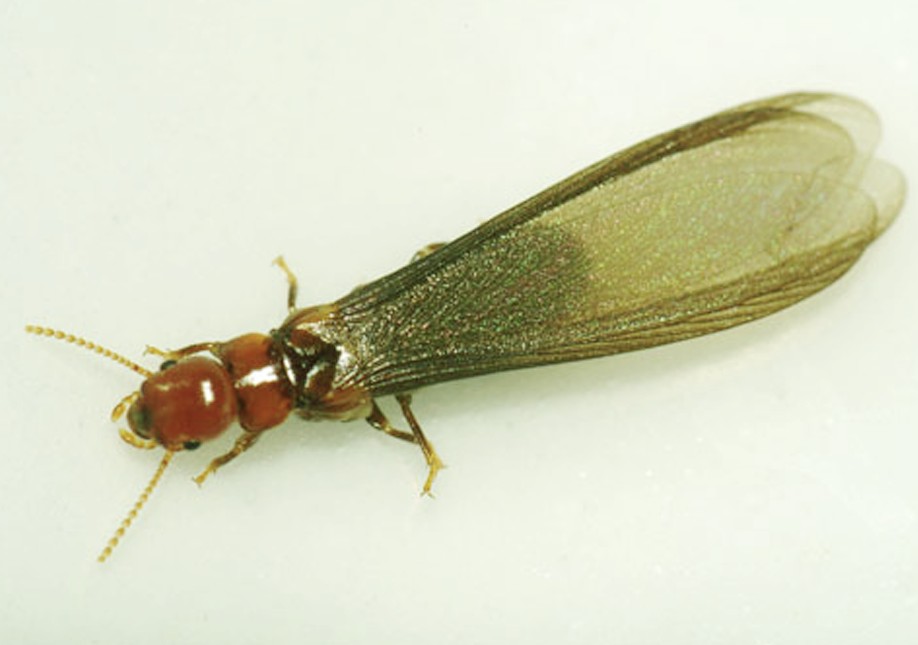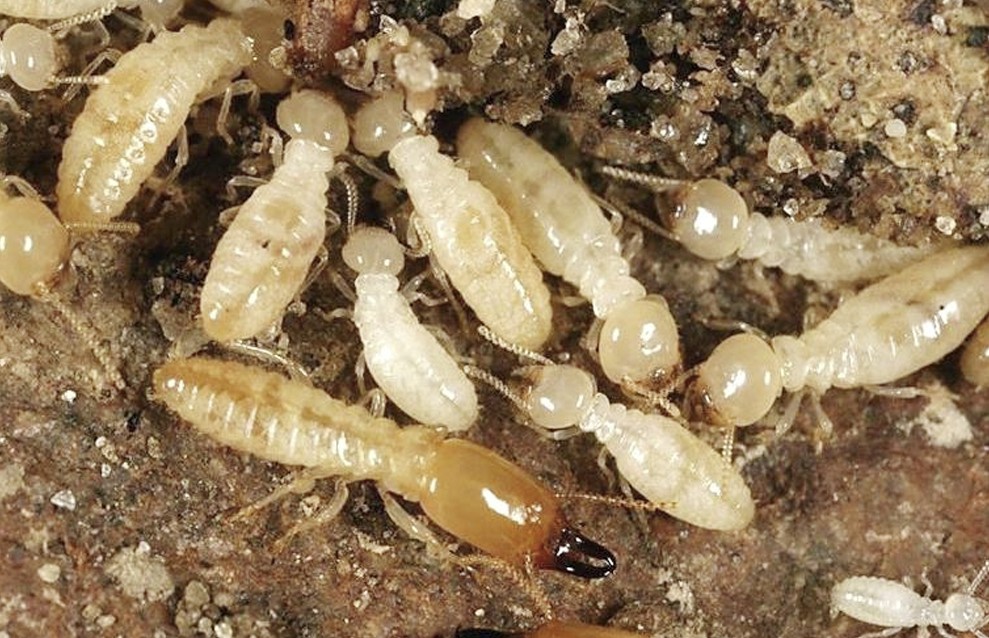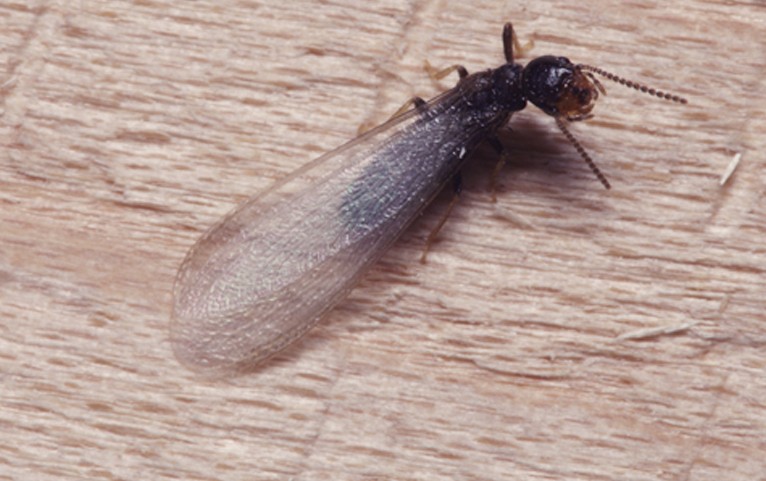Drywood Termites
What are Drywood Termites?

Drywood termites are the wood-eating insects that can cause a severe threat to your homes, furniture, frames, roofs, and flooring. These termites come from the Kalotermitidae family and are found in the Southwest U.S, northwest Mexico, and some parts of Australia where the moisture content is very low. Drywood termites are native to these areas but can be transported to other places through the infested wooden furniture or other structures.
Their largest colony has about 5,000 inhabitants, and unlike subterranean termites, they build homes within moisture-free wood such as native and orchard trees, furniture, utility posts, and other wooden structures. Interestingly, they eat the same thing they live in, i.e., wood. These termites always stay above the ground and do not need any contact with the soil to survive.
Cryptotermes brevis, commonly known as the West Indian drywood termite or powderpost termite is the most economically significant termite in the Kalotermitidae family. It is capable of infesting wooden articles and structures completely, so much so, that at one time they were known as the “furniture termite.”
What do Drywood Termites look like?

The size of Drywood termites depends on the caste. The reproductives are about one-half of an inch long; workers are one-fourth of an inch, and soldiers are approximately three-eighths of an inch long.
Almost all Drywood termites have straight antennae, short legs, and a thick waist. The soldier caste has mandibles or mouthparts with teeth.
Typically, the colour of a Drywood termite varies based on maturity and caste. It goes from pale brown to dark brown to yellowish- tan. Mostly, the worker caste is white in colour, soldier termites are brown or cream-coloured, and alates are generally black or brown-coloured. The wings of flying termites or alates are usually clear or can be smokey grey in colour.
What is the Behaviour of Drywood Termites?
As with other termite species, Drywood termites are social bugs that live in caste-based colonies. There is a minimum of 1000 termites in every colony, and a mature colony can contain up to 5000 inhabitants.
These termites divide responsibilities for reproduction, food hunting, and colony protection based on caste. The queen, king, and alates form the reproductive caste, then come to the workers and soldiers.
Unlike the colonies of subterranean termites, there is no true worker caste in case of Drywood termites. The young termites do the work of the traditional workers’ caste and are known as false workers or pseudergates.
The queen termite keeps looking for the right spot for a colony mostly in the internal framework of wooden roofs. Once she finds a perfect home, she chooses a king. She begins laying eggs soon after mating. Once the eggs hatch, some of them turn into pre soldiers, and others become nymphs that will eventually become alates. The remaining larvae develop into workers and take care of the colony and feed the soldier caste.
As soon as a colony age, eventually the nymphs turn into alates. These are also known as reproductive termites as they grow wings, swarm, and fly off in search of choosing the best spot to form new colonies. The soldier caste protects the established termite colonies from other species of termites, ants, and other threats.
Where do Drywood Termites Live?
Unlike the species of subterranean species, Drywood termites do not require water or soil in order to survive, and they can easily bear dry conditions for prolonged periods. The moisture provided by the dry wood is enough for them to thrive.
These termites can be found in the Southwest U.S, northwest Mexico, and some parts of Australia. They can easily enter your homes from the roofs, foundation ventilation, or flat surface. They create their colonies inside the roof, wooden wall supports, woodpiles, dead wood, brush mounds, furniture, and frames. Although they don’t need water to survive, they can still be found nearby water sources like on a water heater or around a leaking pipe.
What do Drywood Termites Eat?
For drywood termites, home and food are one and the same, i.e., wood. Just like other termites, this termite species also get its nutrients from cellulose which is found in wood. They cut across wood grains and absorb the wood. So basically, they feed on everything that contains wood from furniture to roofs to dead tree logs.
Since the workers’ caste is known to be the caretaker and forager of the colony, they distribute their food among the reproductives, soldiers, and the young ones.
How Dangerous are they?
Drywood termites can cause extensive damage to your house. The Infestation can be restricted to just one area or can be rampant. Apparently, these pests weaken the wooden structures from the inside by chewing the tunnels present in the wooden articles. Since these insects eat your wooden objects from the inside out, leaving them untreated can be extremely dangerous.
According to estimates, damage of around a billion dollars is caused to the homes in the USA every year. The infestation caused by Drywood termites is not covered in homeowner insurance policies, and hence, the damage can be costly to repair and may involve the use of home fumigation procedures.
Signs of Drywood Termite Infestation
Swarms
Since Drywood termites form their colonies inside the wood, it can be challenging to detect their presence. Usually, the very first sign of a Drywood termite mature colony is the presence of swarms or alates. These swarms fly out of their nests to create new colonies-which could be inside your home. You can identify them at night near light sources, daytime and during the rainy season. You can also detect their presence by their discarded wings.
Frass
One of the best ways to identify their activity is- frass or termite droppings. Drywood termites tend to push their feces out of small kick holes near the entrances to their colony. Their fecal pellets are small black marks, and unlike the boring excreta of powderpost beetles, Drywood termites’ fecal pellets are much larger in size.
Hollow wood
Drywood termites eat and infest wood completely making it hollow. You will hear a papery sound when you tap on an infested area since the timber inside has been absorbed.
Clicking Noises
If you hear soft clicking sounds coming from the walls, your house is sure infested by Drywood termites. The soldier caste bangs their heads against the wooden walls to alert the colony of any dangers.
Other signs include white ants, tunnels in wood and tight-fitting door and hard-to-open windows.
How to get rid of Drywood Termites?
You need to pull up your socks and get equipped if you’re sure that Drywood termites infest your property.
Bora-Care
Bora-care is one of the most inexpensive, home-based, and safe treatment to get rid of Drywood termites. This concentrated borate and glycol-based product dehydrates these insects and kills their nervous system. Just mix bora-care with water and apply the solution directly on the unpainted wood.
You can also use a sharp syringe to inject it into the wood. It’s not the fastest way to kill these insects, but a correct application of bora-care will treat the existing termites and prevent protection to the wood for a lifetime.
Structural Fumigation
If the infestation is extensive, you’ll need to take help from professionals. To introduce the gas, the structure will be entirely covered with a fumigation tent. This method results in 100% removal of Drywood termites as the gas replaces the oxygen, and upon breathing, this gas is consumed by the termites.
Other Treatments
- If the infestation is limited to just 1-2 areas, remove or replace the damaged wood. However, if the infestation is widespread, try a spot treatment. The professional will drill small holes into the wood and inject foam-based insecticides like liquid nitrogen or Termidor.
- The Orange juice’s concentrate, when mixed with water, works as a great repellent of Drywood termites.
- You can also place the small wooden articles in a large freezer for about 4-5 days. It will surely kill these wood-eaters.
- The heat method is also used to get rid of these creepy pests. Here, the infested house/building is heated for about 33 minutes at a minimum temperature of 120°F. This method can also be used for spot treatment.
Pictures
Take a look at these drywood termites pictures to get to know more about their appearance:



Interesting facts
- The dropping of Drywood termites is quite fancy. Their poop is approx. 1mm long, has six concave sides, oval and hard pellets with rounded ends.
- Drywood termites have many enemies such as lizards, frogs, and birds, but their biggest predator is ants. These termites are rarely found in places where there is an established colony of ants.
- Drywood termites have an essential role in the ecosystem. They help in breaking down the decaying matter, which is very crucial for the renewal program of the earth.
- The scientific name of Western Drywood termites is Incisitermes minor.
Don’t wait too long before taking action if Drywood termites invade your house. In case the damage is extensive, do not rely on DIY treatment methods. Take professional help and throw these awful and creepy pests out from your property. You can also consider an annual termite inspection if your house is prone to these insects.
Hope you enjoyed reading about Drywood termites!
